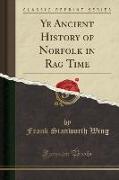- Start
- Ye Ancient History of Norfolk in Rag Time (Classic Reprint)
Ye Ancient History of Norfolk in Rag Time (Classic Reprint)
Angebote / Angebote:
Excerpt from Ye Ancient History of Norfolk in Rag Time
Norfolk, Virginia, many well be described as an island, being situated on a body of land completely surrounded by rivers, creeks, estauries and advertising billboards. Through the interstices of the latter may occasionally be seen glimpses of Chesapeake Bay and the rolling ocean.
The city is at the southeastern end of the State, in latitude 36 degrees, 50 minutes, 50 seconds, north, and observations taken for a period of five years, beginning in 1856, showed that the average temperature is 35 hundredths of a degree cooler than that of Portsmouth, Virginia. This, perhaps, accounts for the fact that all of the summer resorts are located on the Norfolk side of the river.
Taken as a whole, the temperature is mild and equable, although General Ben Butler is said to have complained greatly of frost when he visited here shortly after the Civil War. Officially, the coldest day on record locally was January 23, 1857, when the thermometer registered five degrees below zero at 7 a.m. The Elizabeth was frozen solidly enough to permit the crossing of pedestrians and vehicles for several days, and a barroom was built in the center of the river, being the first time on record when hot Tom and Jerries were servd on ice. The saloon did a rushing business, and a number of Norfolk and Portsmouth people are said to have slipped out there after a few drinks.
While on the weather topic, it may be remarked that Norfolk and Constantinople, Turkey, have the same average temperature - 58.26 degrees. So has Trebizond, on the Black Sea. The thousands of Norfolk people who have visited Trebizond may have noticed this.
Just when Norfolk was settled by so-called civilized people is shrouded in mystery. There is a tombstone in St. Paul's churchyard bearing the date 1642 and the name of a woman, who very possibly may have been one of the maidens told of by Mary Johnson in "To Have And To Hold." Again, while boring for water in 1833, workmen found a strange coin thirty feet below the surface of the earth. This could not be passed at any saloon, and closer examination showed the bit of money to be of either Norwegian or Roman origin. This should excite no wonder. Many strangers have dropped their money in Norfolk.
About the Publisher
Forgotten Books publishes hundreds of thousands of rare and classic books. Find more at www.forgottenbooks.com
This book is a reproduction of an important historical work. Forgotten Books uses state-of-the-art technology to digitally reconstruct the work, preserving the original format whilst repairing imperfections present in the aged copy. In rare cases, an imperfection in the original, such as a blemish or missing page, may be replicated in our edition. We do, however, repair the vast majority of imperfections successfully, any imperfections that remain are intentionally left to preserve the state of such historical works.
Folgt in ca. 5 Arbeitstagen
